Seat belts
SEAT BELT PRECAUTIONS
WARNING:
All occupants of the vehicle must wear their
seat belts at all times. Seat belts and child
restraints reduce the risk of serious or fatal
injuries for all occupants in the event of a
collision or sudden stop. Without a seat
belt, occupants could be shifted too close
to a deploying airbag, strike the interior
structure or be thrown from the vehicle.
Properly worn seat belts greatly reduce these hazards. Even with advanced airbags, unbelted occupants can be severely injured by a deploying airbag. Always follow the precautions about seat belts, airbags and occupant safety contained in this manual.
Infant or Small Child
All 50 states have child restraint laws. You should be aware of the specific requirements in your state. Child and/or infant safety seats must be properly placed and installed in the rear seat.
WARNING:
Every person in your vehicle needs to be
properly restrained at all times, including
infants and children. Never hold a child in
your arms or lap when riding in a vehicle.
The violent forces created during a crash will tear the child from your arms and throw the child against the interior. Always use a child restraint appropriate for your child's height and weight.
NOTE:
Small children are best protected from injury
in an accident when properly restrained
in the rear seat by a child restraint system
that meets the requirements of the Federal
Motor Vehicle Safety Standards. Before
buying any child restraint system, make
sure that it has a label certifying that it
meets Federal Motor Vehicle Safety Standard
213. The restraint must be appropriate
for your child's height and weight. Check
the label on the child restraint for this
information.
Larger Children
Children who are too large for child restraint systems should always occupy the rear seat and use the available lap/shoulder belts. The lap portion should be fastened snug on the hips and as low as possible. Check belt fit periodically. A child's squirming could put the belt out of position.
Children are afforded the most safety in the event of an accident when they are restrained by a proper restraint system in the rear seat. If a larger child (over age 13) must be seated in the front seat, the child should be securely restrained by the available lap/shoulder belt and the seat should be placed in the rearmost position. Children under the age of 13 should be restrained securely in the rear seat. NEVER place a child under the age of 13 in the front seat.
NEVER place a rear facing child seat in the front seat of a vehicle.
Pregnant Women
The use of a seat belt is recommended for pregnant women to lessen the chance of injury in an accident. When a seat belt is used, the lap belt portion should be placed as low and snugly as possible on the hips, not across the abdomen.
For specific recommendations, consult a physician.
Injured Person
A seat belt should be used when an injured person is being transported. When this is necessary, you should consult a physician for recommendations.
One Person Per Belt
Two people (including children) should never attempt to use a single seat belt. This could increase the severity of injuries in case of an accident.
Do Not Lie Down
To reduce the chance of injuries in the event of an accident and to achieve maximum effectiveness of the restraint system, all passengers should be sitting up and the front seats should be in an upright position when the car is moving.
A seat belt cannot provide proper protection if the person is lying down in the rear seat or if the front seat is in a reclined position.
WARNING:
Riding with a reclined seatback increases
your chance of serious or fatal injuries in
the event of a collision or sudden stop. The
protection of your restraint system (seat
belts and airbags) is greatly reduced by
reclining your seat. Seat belts must be snug
against your hips and chest to work properly.
The more the seatback is reclined, the greater the chance that an occupant's hips will slide under the lap belt causing serious internal injuries or the occupant's neck could strike the shoulder belt. Drivers and passengers should always sit well back in their seats, properly belted, and with the seatbacks upright.
CARE OF SEAT BELTS
Seat belt systems should never be disassembled or modified. In addition, care should be taken to assure that seat belts and belt hardware are not damaged by seat hinges, doors or other abuse.
WARNING:
When you return the rear seatback to its
upright position after the rear seatback was
folded down, be careful not to damage the
seat belt webbing or buckle. Be sure that
the webbing or buckle does not get caught
or pinched in the rear seat. A seat belt with
damaged webbing or buckle will not be as
strong and could possibly fail during a
collision or sudden stop, resulting in serious
injury.
Periodic Inspection
It is recommended that all seat belts be inspected periodically for wear or damage of any kind. Parts of the system that are damaged should be replaced as soon as possible.
Keep Belts Clean and Dry
Seat belts should be kept clean and dry. If belts become dirty, they can be cleaned by using a mild soap solution and warm water. Bleach, dye, strong detergents or abrasives should not be used because they may damage and weaken the fabric.
When to Replace Seat Belts
Entire in-use seat belt assembly or assemblies should be replaced if the vehicle has been involved in an accident. This should be done even if no damage is visible. Additional questions concerning seat belt operation should be directed to your Hyundai Dealer.
HEIGHT ADJUSTABLE FRONT SEAT SHOULDER BELT
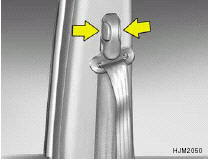
You can adjust the height of the shoulder belt anchor to one of the 4 positions for maximum comfort and safety.
If the height of the adjusting seat belt is too near your neck, you will not be getting the most effective protection. The shoulder portion should be adjusted so that it lies across your chest and midway over your shoulder nearest the door and not your neck.
To adjust the height of the seat belt anchor, lower or raise the height adjuster into an appropriate position. To raise the height adjuster, pull it up. To lower it, push it down while pressing the height adjuster button.
Release the button to lock the anchor into position. Try sliding the height adjuster to make sure that it has locked into the position.
WARNING:
o Verify the shoulder belt anchor is locked
into position at the appropriate height.
Never position the shoulder belt across your neck or face. Improperly positioned seat belts can cause serious injuries in an accident.
o Failure to replace seat belts after an accident could leave you with damaged seat belts that will not provide protection in the event of another collision leading to personal injury or death.
Replace your seat belts after being in an accident as soon as possible.
SEAT BELT-Driver's 3-Point System with Emergency Locking Retractor To Fasten Your Belt
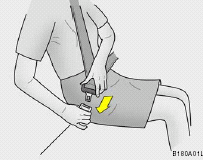
To fasten your seat belt, pull it out of the retractor and insert the metal tab into the buckle. There will be an audible "click" when the tab locks into the buckle.
The seat belt automatically adjusts to the proper length only after the lap belt portion is adjusted manually so that it fits snugly around your hips.
If you lean forward in a slow, easy motion, the belt will extend and let you move around. If there is a sudden stop or impact, however, the belt will lock into position. It will also lock if you try to lean forward too quickly.
NOTE:
o If you are not able to pull out the safety
belt from the retractor, firmly pull the belt
out and release it. Then you will be able
to pull the belt out smoothly.
o If the driver's seat belt is not fastened when the ignition key is in the "ON" position, the seat belt warning light will flash and the warning chime will sound for approximately six seconds.
SEAT BELTS-Front Passenger and Rear Seat 3-Point System with Combination Locking Retractor
Combination retractor type seat belts are installed in the rear seat positions to help accommodate the installation of child restraint systems.
Although a combination retractor is also installed in the front passenger seat position, Hyundai strongly recommends that children always be seated in the rear seat. NEVER place any infant restraint system in the front seat of the vehicle.
This type of seat belt combines the features of both an emergency locking retractor seat belt and an automatic locking retractor seat belt. To fasten your seat belt, pull it out of the retractor and insert the metal tab into the buckle. There will be an audible "click" when the tab locks into the buckle. When not securing a child restraint, the seat belt operates in the same way as the driver's seat belt (Emergency Locking Retractor Type). It automatically adjusts to the proper length only after the lap belt portion of the seat belt is adjusted manually so that it fits snugly around your hips. When the seat belt is fully extended from the retractor to allow the installation of a child restraint system, the seat belt operation changes to allow the belt to retract, but not to extend (Automatic Locking Retractor Type).
NOTE:
Although the combination retractor provides
the same level of protection for seated
passengers in either emergency or automatic
locking modes, it is recommended
that seated passengers use the emergency
locking feature for improved convenience.
The automatic locking function is intended to facilitate child restraint installation. To convert from the automatic locking feature to the emergency locking operation mode, allow the unbuckled seat belt to fully retract.
WARNING:
o For maximum restraint system protection,
the seat belts must always be used
whenever the car is moving.
o Seat belts are most effective when seatbacks are in the upright position.
o Children age 12 and younger must always be properly restrained in the rear seat. Never allow children to ride in the front passenger seat. If a child over 13 must be seated in the front seat, he/she must be properly belted and the seat should be moved as far back as possible.
o Never wear the shoulder belt under your arm or behind your back. An improperly positioned shoulder belt can cause serious injuries in a crash. The shoulder belt should be positioned midway over your shoulder across your collarbone.
o Avoid wearing twisted seat belts. A twisted belt can't do its job as well. In a collision, it could even cut into you. Be sure the belt webbing is straight and not twisted.
o Be careful not to damage the belt webbing or hardware. If the belt webbing or hardware is damaged, replace it.
Adjusting Your Seat Belt
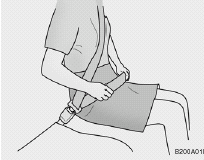
WARNING:
You should place the lap belt portion as low
as possible and snugly across your hips,
not on your waist. If the lap belt is located
too high on your waist, it may increase the
chance of injury in the event of a collision.
Both arms should not be under or over the belt. Rather, one should be over and the other under, as shown in the illustration.
Never wear the seat belt under the arm nearest the door.
To Release the Seat Belt
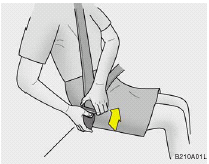
The seat belt is released by pressing the release button in the locking buckle. When it is released, the belt should automatically draw back into the retractor.
If this does not happen, check the belt to be sure it is not twisted, then try again.
SEAT BELTS - Center Rear Seat 3-Point System With Combination Locking Retractor
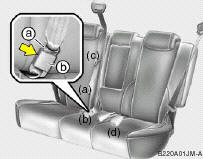
1. Before fastening the rear seat center belt, confirm the metal tab (a) and buckle (b) are latched together.
2. After confirming that (a) and (b) are latched, pull the seat belt out of the retractor and insert the metal tab (c) into the buckle (d).
There will be an audible "click" when the tab locks in the buckle. The seat belt automatically adjusts to the proper length only after the lap belt is adjusted manually so that it fits snugly around your hips. If you lean forward in a slow, easy motion, the belt will extend and let you move around. If there is a sudden stop or impact, the belt will lock into position. It will also lock if you try to lean forward too quickly.
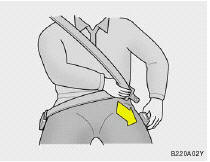
WARNING:
o Never let anyone ride in the rear center
seat without fastening all metal tabs and
buckles as described in this section.
This seat belt is designed to function as a typical 3-point restraint (lap/shoulder belt). Using only the shoulder portion or lap portion of the belt can result in serious or fatal injuries in the event of a collision or sudden stop.
WARNING:
o Never unlock the metal tab (a) and the
buckle (b) with the following exceptions.
(1)In case of folding rear seatbacks down.
(2) If transporting an object on the rear seat may cause damage to the rear seat center belt.
o Always lock metal tab (a) into buckle (b) immediately after returning the rear seatbacks to an upright position. This portion of the rear center seat belt should only be unbuckled when the rear seatback is folded down.
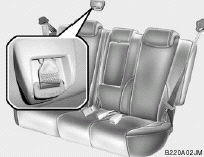
o In case of unlocking metal tab (a) and the buckle (b), place metal (a) in the seat belt clip not to make noise while driving.
To disconnect the metal tab (a) from the buckle (b) , insert a narrow-ended tool into the groove located on the buckle (b).
To Release the Seat Belt
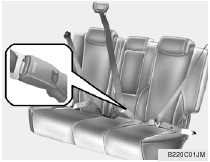
When you want to release the seat belt, press the button in the locking buckle.
WARNING:
The rear seat center belt latching mechanism
is different from those for the outboard
rear seat shoulder belts. When fastening
the outboard rear seat shoulder belts
or the rear seat center belt, make sure they
are inserted into the correct buckles to
obtain maximum protection from the seat
belt system and assure proper operation.
See also:
ADVANCED STANDARD SAFETY TECHNOLOGIES: PART OF HYUNDAI'S ASSURANCE COMMITMENT
Hyundai Elantra was one of the first compact sedans with ESC when it launched in July of 2007. The 2011 Elantra now takes compact car safety to the next level with the introduction of Vehicle Stabil ...
Before Starting the Engine
Before you start the engine, you should always:
1. Look around the vehicle to be sure there are no flat tires, puddles of oil
or water or other indications of possible trouble.
2. After entering t ...
Tilt steering
Tilt steering allows you to adjust the steering wheel before you drive. You can
also raise it to give your legs more room when you exit and enter the vehicle.
The steering wheel should be positione ...


